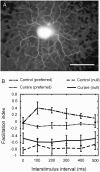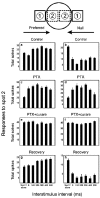Starburst cells nondirectionally facilitate the responses of direction-selective retinal ganglion cells
- PMID: 12486140
- PMCID: PMC6758446
- DOI: 10.1523/JNEUROSCI.22-24-10509.2002
Starburst cells nondirectionally facilitate the responses of direction-selective retinal ganglion cells
Abstract
The mechanism of direction selectivity in retinal ganglion cells remains controversial. An important issue is how the starburst amacrine cells, which are known to provide a major synaptic input to the direction-selective ganglion cells, participate in the directional discrimination. Here, we present evidence that the cholinergic outputs of the starburst cells affect the responses of the ganglion cells symmetrically; they provide a feedforward excitation that facilitates the response of the ganglion cells to movement in both the preferred and null directions. This seems to place a constraint on models of the directional discrimination in which the starburst cells participate, namely, that their cholinergic synapses be nondirectional in their effects on the ganglion cells.
Figures




References
-
- Amthor FR, Grzywacz NM, Merwine DK. Extra-receptive-field motion facilitation in on-off directionally selective ganglion cells of the rabbit retina. Vis Neurosci. 1996;13:303–309. - PubMed
-
- Borg-Graham LJ. The computation of directional selectivity in the retina occurs presynaptic to the ganglion cell. Nat Neurosci. 2001;4:176–183. - PubMed
Publication types
MeSH terms
Substances
LinkOut - more resources
Full Text Sources
